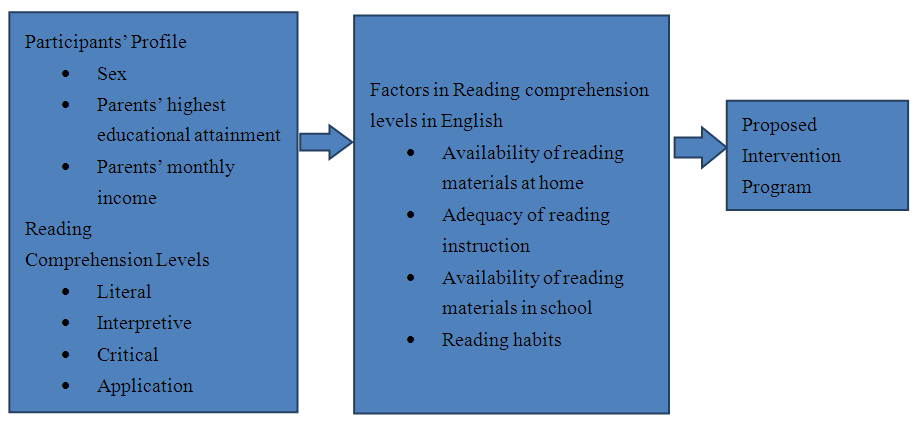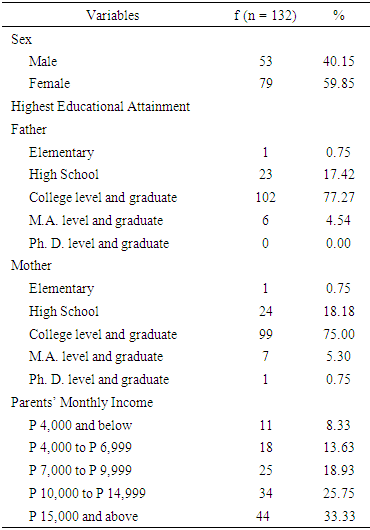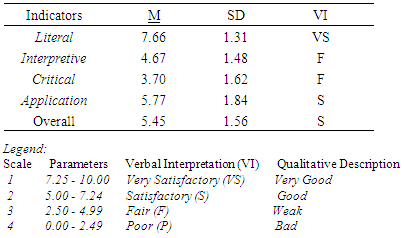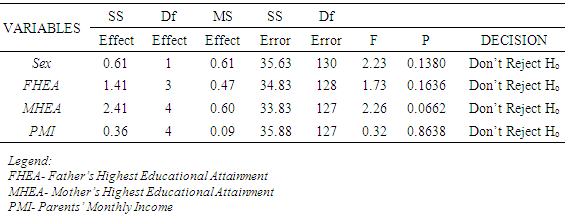-
Paper Information
- Next Paper
- Paper Submission
-
Journal Information
- About This Journal
- Editorial Board
- Current Issue
- Archive
- Author Guidelines
- Contact Us
Education
p-ISSN: 2162-9463 e-ISSN: 2162-8467
2018; 8(1): 5-8
doi:10.5923/j.edu.20180801.02

Reading Comprehension Levels in English among Grade 7 Students in Caraga State University, Philippines
Petervir A. Paz
Caraga State University, Butuan City, Philippines
Correspondence to: Petervir A. Paz, Caraga State University, Butuan City, Philippines.
| Email: |  |
Copyright © 2018 Scientific & Academic Publishing. All Rights Reserved.
This work is licensed under the Creative Commons Attribution International License (CC BY).
http://creativecommons.org/licenses/by/4.0/

The study determined the reading comprehension levels in English of Grade 7 students of Caraga State University, Cabadbaran, Agusan del Norte. It also described the profile of the participants and the perceived factors which determine the participants’ reading comprehension levels in terms of availability of literary reading materials at home, adequacy of reading instruction in reading, availability of reading materials in school, and reading habits. The study made use of the descriptive research design using survey technique and a researcher-made questionnaire. There were 132 participants involved in the study. The statistical tools used were Frequency count and Percentage distribution, the Mean and Standard Deviation (SD), t-test, and analysis of variance. It was found out that there was no significant relationship between the participants’ profile and factors of reading toward their reading comprehension level. It gave way to deal with some of the levels of reading comprehensions that were weak, namely interpretative, critical, and application that requires desirable intervention program.
Keywords: English language, Reading comprehension, Reading comprehension levels, Profile of the participants, Reading factor
Cite this paper: Petervir A. Paz, Reading Comprehension Levels in English among Grade 7 Students in Caraga State University, Philippines, Education, Vol. 8 No. 1, 2018, pp. 5-8. doi: 10.5923/j.edu.20180801.02.
Article Outline
1. Introduction
- English language is a medium of communication which helps the members of a community to communicate and interact with one another. It involves both verbal and non-verbal communication. Reading is a nonverbal communication that enriches ones greater understanding and vocabulary [1].In schools, knowledge and information in English have been acquired often by reading. It has been an outstanding skill in getting information through translation and understanding the written text from different reading materials [4]. It has been considered the first provider of relevant information for other communication skills such as writing, speaking, and listening [3].As observed, the demand for English proficiency through reading among students is rising. Reading comprehension levels (literal, interpretive, critical, and application) have to be introduced to students for deeper understanding and better usage of the appropriate texts read [5]. This attracted considerable attention in the present study. Despite the student’s mastery of the basic elements of English such as grammar and vocabulary, their reading comprehension levels still need improvement. There is that 10 to 15% of the general school population had experienced difficulty in reading [3]. She said that reading difficulties are the principal causes of failure in school. Reading experiences strongly influence a student’s feeling of competency. If not achieved, there could be reading failure that may lead to misbehavior, anxiety, and lack of motivation in comprehending any of the reading materials in English [6]. It is within this context that the researcher was prompted to study the reading comprehension levels in English of the Grade 7 students of Caraga State University High School, Cabadbaran City, Agusan del Norte.
2. Theoretical and Conceptual Framework
- In the context of the present research, the framework of the study is illustrated at the research paradigm in figure 1 below. The first box on the upper left contains the participants profile in terms of sex, parents’ highest educational attainment, and parents’ monthly income. The second box on the lower left contains the factors which determine the participants’ reading comprehension levels in English such as literal, interpretive, critical, and application. Literal level refers to the acquisition of information that is directly stated in a selection. Interpretive Level is “reading between the line” in which connotative meanings of the line are well-understood, and making inferences. Critical level refers to the evaluation of ideas and information. Application Level refers to the drawing of insights and conclusions from the reading text which can be applied in the real situations. The third box at the center contains the factors which determine the participants’ comprehensive levels in English in terms of reading which include the availability of literary reading materials at home, adequacy of reading instruction, availability of reading material in school, and reading habits.
 | Figure 1. The Research Paradigm |
3. Research Design and Methodology
- The study made used of the descriptive-survey design. This served as a technique which focused and identified the participants’ profile, the factors of reading, and listening and their reading comprehension levels that are weak. It sought to answer the following questions on the profile of the participants, on their level of comprehension, on factors determining their reading comprehension, and on their levels of significance and difference to both profile and reading factors. All three Grade 7 sections served as respondents.In gathering the data, the researcher-made questionnaire was used. The instrument consisted of three important parts: Part I was used to determine the profile of the participants. Part II of the questionnaire solicited the participants’ levels of reading comprehension and anchored on the Higher Order Thinking Skills on the work of Castigador (2007). A pretest was administered to the Grade 7 students of Father Saturnino Urios University-High School at Ampayon, Butuan City for its validation. Part III dealt with the factors that determine the participants’ reading comprehension levels in English on the Reading Factors.The data gathered were statistically tabulated, analyzed, and interpreted through Frequency and percentage distribution, Mean and Standard deviation, the t-test, and the analysis of variance. The result was dealt with the nonparametric test for parameters estimation of the distribution from the sample data. It determines the ordinal variables as an outcome for interpretation.
4. Results and Discussions
- Table 1 below shows the profile of Grade 7 students. As indicated in the same table, 53 (40.15%) of the participants are males and 79 (59.85%) are females with a total of 132. The result shows that female students are greater in number. As to their parents’ educational attainment, it can be gleaned that it has the total of 102 (77.27%). These point out that a majority of their parents entered college and educated. This provides the greater social status of the family. As to their parents’ monthly income, it can be gleaned in the table that there were 44 (33.33%) of the income earned by both parents ranging from P15,000 and above, and 34 (25.75%) parents had an income of P10,000 to P14,000. This implies that majority of the participants have parents who can support them to school and even provide materials at home for personal consumption. The rest belongs to the age brackets of P7,000 to P9,999 down to below P4,000. This emphasizes a degree of deficiency to be provided to the students in terms of materials at home for reading improvements.
|
|
|
|
|
5. Conclusions
- Based on the findings of the study, the following conclusions were drawn: (1) the majority of the participants were females and their parents were on college levels or college graduates, and had good income; (2) both the interpretive and critical levels of reading comprehension of the Grade VII students are fair; (3) the factors that determine both the reading comprehensions of the students are extensive; (4) the profile variables of the students do not affect their reading comprehension levels; (5) the factors that determine the reading comprehension of the students are not related to their reading comprehension levels. These imply that English teachers should consider programs and activities in school that develop students’ critical and interpretive thinking, and conduct regular evaluation to monitor their academic progress in reading comprehensions.
ACKNOWLEDGMENTS
- A special gratitude to Jemson Palin for organizing and editing this research.
 Abstract
Abstract Reference
Reference Full-Text PDF
Full-Text PDF Full-text HTML
Full-text HTML



